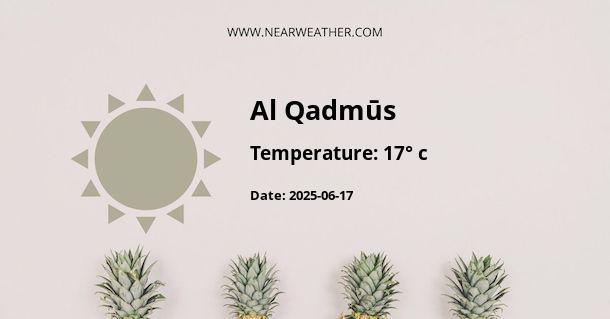Introduction
Al Qadmus, a hidden gem in Syria, is known for its historical significance and diverse climate. This unspoiled town, located in the Tartus Governorate, offers a unique mix of Mediterranean and semi-arid weather, making it a fascinating case study for weather aficionados.
Overview of Al Qadmus Climate
Al Qadmus experiences a Mediterranean climate (Köppen climate classification: Csa), characterised by hot dry summers and mild, wet winters. However, its geographical location in the coastal mountain range contributes to the semi-arid influences.
Monthly Weather Conditions
To understand the climate of Al Qadmus, let's delve into its monthly weather conditions.
| Month | Average Max Temperature (°C) | Average Min Temperature (°C) | Monthly Precipitation (mm) |
|---|---|---|---|
| January | 14 | 7 | 130 |
| February | 15 | 8 | 120 |
| March | 17 | 9 | 90 |
Seasonal Weather Variations
1. Summer (June - August)
Summer in Al Qadmus is typically hot and dry, with temperatures often exceeding 30°C. The region experiences very little rainfall during this season, contributing to its semi-arid climate classification.
2. Autumn (September - November)
Autumn signifies the transition from the hot summer to the mild winter. Temperatures gradually decrease, and there is an increase in rainfall, especially towards the end of the season.
3. Winter (December - February)
Winter in Al Qadmus is mild and wet. The average maximum temperature rarely drops below 15°C, and the region experiences the most precipitation during this season. Snowfall, however, is rare due to the coastal influence.
4. Spring (March - May)
Spring is characterized by mild temperatures and moderate rainfall. The landscape comes alive with lush greenery and blooming flowers, making it the most picturesque season in Al Qadmus.
Annual Weather Patterns
Al Qadmus' annual weather patterns are influenced by its Mediterranean climate and its unique geographical location. The annual average temperature is around 20°C, with the hottest month being July (average temperature: 31°C) and the coldest month being January (average temperature: 10°C). The average annual rainfall is approximately 800mm, with the wettest month typically being January.
Impact of Climate Change
Like many other regions globally, Al Qadmus is not immune to the impacts of climate change. Researchers have noted an increase in average temperatures and a decrease in annual rainfall over recent decades, which could have significant implications for the region's agriculture and water resources.
Conclusion
In conclusion, Al Qadmus offers a unique climate, shaped by its Mediterranean and semi-arid influences. Its diverse weather patterns, ranging from hot, dry summers to mild, wet winters, are a testament to the dynamic and ever-changing nature of our planet's climate. However, as climate change continues to make its mark, it's more important than ever to understand and protect the unique climates of small towns like Al Qadmus.
A - Al Qadmūs's Latitude is 35.098541 & Longitude is 36.159840.
A - Weather in Al Qadmūs is 10° today.
A - Climate Conditions in Al Qadmūs shows overcast clouds today.
A - Humidity in Al Qadmūs is 84% today.
A - Wind speed in Al Qadmūs is 18.4 km/h, flowing at 261° wind direction. today.
